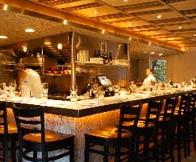Out in the Great Wide Open
 Used to be, the organized chaos of a restaurant kitchen was a tucked-away affair, hidden from the view of a paying public who preferred to dine far away from hot burners and splattering grease, thankyouverymuch. If you wanted to see your food being cooked, you’d have to go to a sushi bar or a shrimp-flinging Japanese steakhouse.
Used to be, the organized chaos of a restaurant kitchen was a tucked-away affair, hidden from the view of a paying public who preferred to dine far away from hot burners and splattering grease, thankyouverymuch. If you wanted to see your food being cooked, you’d have to go to a sushi bar or a shrimp-flinging Japanese steakhouse.
These days, many of the city’s top restaurants prepare their food in full view of the folks who’ll be eating it. Chefs and their knife skills practices are on full display at upscale eateries like Craigie on Main, B&G Oysters, Sportello, Scampo, and Ten Tables in JP (which is expanding to include a bar in December). The seats closest to the action are often the most coveted.
For restaurateurs, an open kitchen is a double-edged chef’s knife. On the one hand, it forces kitchen staff to interact with its clientele, and allows customers to see how the tasty magic happens. On the other, it puts things that might be better concealed—like kitchen injuries, dropped loaves of bread, and staffers spouting profanities—out for all to see and hear. Is the interaction really worth it?
Post 390 chef Eric Brennan believes it is; a large open kitchen creates a more “comfortable” atmosphere with energy, drama and exposure, he says. Greg Digiovanni of Charlestown’s petite Navy Yard Bistro believes that openness “keeps you on your toes,” and that the din of bubbling pots, sizzling pans, clattering dishes, and back-and-forth calls between chefs and keeps things lively. “[It] promotes an overall good feeling,” he says.
But as customers, does it behoove us to know exactly what goes into the preparation? Chef Mary Dumont of Cambridge’s Harvest is “not big on secrets,” she says, and doesn’t let the restaurant’s layout dictate her behavior or cooking style. “There are heated moments when I wish it wasn’t there, but I don’t hold back,” she says. For eavesdropping diners, it’s dinner and a show.
—Elizabeth Elfman


